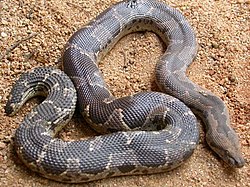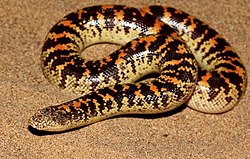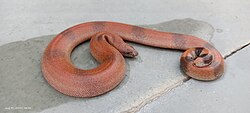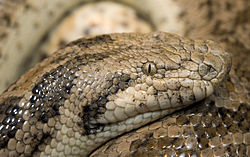| Species [2] | Taxon author [2] | Subspecies* [2] | Common name | Geographic range [1] |
|---|
| Eryx borrii [4] | Lanza & Nistri, 2005 | 0 | Borri's sand boa | Somalia |
Eryx colubrinus  | (Linnaeus, 1758) | 2 | Egyptian sand boa, Kenyan sand boa | Egypt, Sudan, South Sudan, Ethiopia, Eritrea, Kenya, Tanzania, Somalia |
Eryx conicus  | (Schneider, 1801) | 0 | Rough-tailed sand boa, common sand boa | Pakistan, Nepal, India, Sri Lanka |
| Eryx elegans | (Gray, 1849) | 0 | Central Asian sand boa | Southern Turkmenistan, northern Iran (the Kopet Dag Mountains in the northeast and the Azerbaijan region in the northwest) and Afghanistan |
Eryx jaculus  | (Linnaeus, 1758) | 0 | Javelin sand boa | Southern Italy, Eastern Europe in Romania, Bulgaria, Yugoslavia, Albania and Greece (including Corfu and the Cyclades). The Caucasus. The Middle East in Syria, Israel, northeastern Saudi Arabia, Iraq and Iran. Africa north of the Sahara Desert from Morocco to Egypt. |
Eryx jayakari  | Boulenger, 1888 | 0 | Arabian sand boa | From the east and south of the Arabian Peninsula north to Khūzestān Province in Iran |
Eryx johnii  | (Russell, 1801) | 0 | Indian sand boa | From Iran through Pakistan into northwestern and southern India |
Eryx miliaris  | (Pallas, 1773) | 0 | Dwarf sand boa | From the northern Caucasus and the north coast of the Caspian Sea east through Kazakhstan to the north coast of the Aral Sea and Lake Balkhash, though the Zaysan Valley to Sinkiang in China and southern Mongolia. Also in northern and eastern Iran, Afghanistan and western Pakistan. |
Eryx muelleri  | (Boulenger, 1892) | 1 | Müller's sand boa | Mauritania, Senegal, Gambia, Guinea, Mali, Burkina Faso, Niger, Chad, Sudan, South Sudan, the Ivory Coast, Ghana, Togo, Benin, Nigeria, Cameroon, the Central African Republic |
| Eryx sistanensis | Eskandarzadeh, N. Rastegar-Pouyani, E. Rastegar-Pouyani, Zargan, Hajinourmohamadi, Nazarov, Sami, Rajabizadeh, Nabizadeh & Navaian, 2020 | 0 | Sistan sand boa | Iran |
| Eryx somalicus | Scortecci, 1939 | 0 | Somali sand boa | Somalia |
| Eryx vittatus | (Chernov, 1959) | 0 | | Northern Iran, Tajikistan, northern Afghanistan, northern Pakistan, Kyrgyzstan, and eastern China |
Eryx whitakeri  | Das, 1991 | 0 | Whitaker's sand boa | Southwestern coastal India in Kerala, Karnataka, Goa and southern Maharashtra |
|







